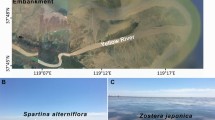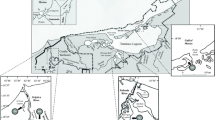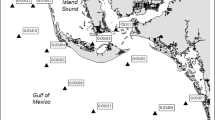Summary
Detritus from common seagrasses and other marine angiosperms may often be a less important basis for estuarine food webs than previously believed. In NW Gulf of Mexico seagrass meadows, epiphytic algae have high productivities, palatability, and a more important trophic role than common large plants have. Interdisciplinary field experiments show (1) intensive night-time ingestion of epiphytes by various invertebrate “detritivores”, (2) very high productivity of epiphytic algae on seagrasses, and (3) assimilation of epiphytes rather than seagrasses, as measured by δ13C comparisons. These combined data show that many naturally concentrated and potentially competing invertebrates in Gulf of Mexico seagrass meadows feed largely on the algal overgrowth on seagrass blades, even when such algae appear to be sparse. Primary productivity of these epiphytic algae can equal that of the seagrasses, per blade or per unit biomass. Animal δ13C values tracked epiphytic values rather than seagrass values when comparisons were made over six sites. These measurements reinforce the view that epiphytic algae can be the primary basis of the food web in seagrass meadows.
Similar content being viewed by others
References
Cates RG, Orians GH (1975) Successional status and the palatability of plants to generalized herbivores. Ecology 56:410–418
Connell JH, Slatyer RO (1977) Mechanisms of succession in natural communities and their role in community stability and organization. Amer Natur 111:1119–1144
Conover JT (1964) The ecology, seasonal periodicity, and distribution of benthic plants in some Texas lagoons. Bot Mar 7:4–41
Cowper SW (1978), The drift algae community of seagrass beds in Redfish Bay, Texas. Contr Mar Sci 21:125–132
Craig H (1957) Isotopic standards for carbon and oxygen, and correction factors for mass-spectrometric analysis of carbon dioxide. Geochim Cosmochim Acta 12:139–149
Darnell RM (1967) Organic detritus in relation to the estuarine ecosystem. In: Lauff GH (ed) Estuaries, Publ 83 AAAS, Wash, D.C., pp 376–382
Dempsey AC, Kitting CL, Rosson RA (in prep) Increased bacterial populations in the stomachs of shrimps that assimilate epiphytic algae
DeNiro MJ, Epstein S (1978) Influence of diet on the distribution of carbon isotopes in animals. Geochim Cosmochim Acta 42:495–506
Fenchel T (1970) Studies on the decomposition of organic detritus derived from turtle grass Thalassia testudinum. Limnol Oceanogr 15:14–20
Fry B, Parker PL (1979) Animal diet in Texas seagrass meadows: δ13C evidence for the importance of benthic plants. Est Coast Mar Sci 8:499–509
Fry B, Scalan RS, Parker PL (1977) Stable carbon isotopic evidence for two sources of organic matter in coastal sediments: seagrasses and plankton. Geochim Cosmochim Acta 41:1875–1880
Fry B, Joern RA, Parker PL (1978) Grasshopper food web analysis: Use of carbon isotope ratios to examine feeding relationships among terrestrial herbivores. Ecology 59:498–506
Fry B, Lutes R, Northam M, Ogden J, Parker P (1982) 13C/12C food web relationships of Caribbean seagrass meadows and coral reefs. Aquat Bot 14:389–398
Haines EB, Montague CL (1979) Food sources of estuarine invertebrates analyzed using 13C/12C ratios. Ecology 60:48–56
Harrison PG, Chan AT (1980) Inhibition of the growth of microalgae and bacteria by extracts of eelgrass (Zostera marina) leaves. Mar Biol 51:21–26
Hedgpeth JW (1953), An introduction to the zoogeography of the northwestern Gulf of Mexico with reference to the invertebrate fauna. Publ Inst Mar Sci UT 3:109–224
Holt SA, Kitting CL, Arnold CR (1983) Distribution of young red drums among different seagrass meadows. Trans Amer Fish Soc 112:267–271
Kikuchi T (1980) Faunal relationships in temperate seagrass beds. In: Phillips RC, McRoy CP (eds) Handbook in Seagrass Biology, Garland STPM Press, New York, pp 153–172
Kitting CL (1979) Using feeding noises to determine the algal foods being consumed by individual intertidal molluscs. Oecologia (Berlin) 40:1–18
Kitting CL (1980) Two molluscs browsing along a gradient of overgrowth along growing seagrass blades (abstract). Amer Zool 20:921 (full paper in Rankin MA (ed in chief): Proc Symp Migr Mech Adap. Signif, Contr Mar Sci Suppl 27 1984)
Lubchenco J (1978) Plant species diversity in a marine intertidal community: importance of herbivore food preference and algal competitive abilities. Amer Natur 112:23–39
McConnaughey T, McRoy CP (1979) 13C label identifies eelgrass (Zostera marina) carbon in an Alaskan estuarine food web. Mar Biol 53:263–269
McMillan C, Zapata O, Escobar L (1980) Sulphated phenolic compounds in seagrasses. Aquat Bot 8:267–278
Morgan MD (1980) Grazing and predation of the grass shrimp Palaemonetes pugio. Limnol Oceanogr 25:896–902
Morgan MD, Kitting CL (1984) Productivity and utilization of the seagrass Halodule wrightii and its attached epiphytes. Limnol Oceanogr (in press)
Odum EP, de la Cruz AA (1967) Particulate organic detritus in a Georgia salt marsh-estuarine ecosystem. In: Lauff GH (ed) Estuaries, Publ 83 AAAS, Wash. DC, pp 383–394
Odum HT, Wilson RF (1962) Further studies on reaeration and metabolism of Texas bays. contr Mar Sci 8:23–55
Ogden JC (1980) In: Phillips RC, McRoy CP (eds) Handbook in Seagrass Biology, Garland STPM Press, NY, pp 173–197
Orians GH, Janzen DH (1974) Why are embryos so tasty? Amer Natur 108:581–92
Penhale PA (1977) Macrophyte-epiphyte biomass and productivity in an eelgrass (Zostera marina. L.) community. J Exp Mar Biol Ecol 26:211–224
Petersen CGJ, Jensen PB (1911) Animal life of the sea-bottom, its food and quantity. Rep Danish Biol Sta (Copenhagen) 20:3–78
Sofer E (1980) Preparation of carbon dioxide for stable carbon isotope analysis of petroleum fractions. Anal Chem 52:2389–1391
Teal JM (1962) Energy flow in the salt marsh ecosystem of Georgia. Ecology 43:614–624
Tenore KR (1977) Growth of the polychaete Capitella capitata, cultured on different levels of detritus derived from various sources. Limnol Oceanogr 22:936–941
Thayer GW, Wolfe DA, Williams RB (1975), The impact of man on seagrass systems. Amer Sci 63:288–296
Thayer GW, Parker PL, LaCroix MW, Fry B (1978) The stable carbon isotope ratio of some components of an eelgrass, Zostera marina, bed. Oecologia (Berlin) 35:1–12
Valiella I, Koumjian L, Swain I, Teal JM, Hobbie JE (1979) Cinnamic acid inhibition of detritus feeding. Nature 280:55–57
Van Montfrans J, Orth RJ, Vay SA (1982) Preliminary studies of grazing by Bittium varium on eelgrass periphyton. Aq Bot 14:75–89
Westlake DF (1963) Comparisons of plant productivity. Biol Rev 38:385–420
Zimmerman R, Gibson R, Harrington J (1979) Herbivory and detritivory among gammaridean amphipods from a Florida seagrass community. Mar Biol 54:41–47
Author information
Authors and Affiliations
Additional information
Contribution No. 608 of The University of Texas Marine Science Institute
Rights and permissions
About this article
Cite this article
Kitting, C.L., Fry, B. & Morgan, M.D. Detection of inconspicuous epiphytic algae supporting food webs in seagrass meadows. Oecologia 62, 145–149 (1984). https://doi.org/10.1007/BF00379006
Received:
Issue Date:
DOI: https://doi.org/10.1007/BF00379006




